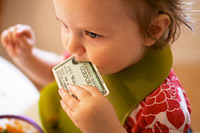Eat Healthier By Leaving Your Credit Cards At Home

(_Dinkel_)
In the last few decades, Americans use credit (or debit) cards for more and more of our everyday spending. We’re also, collectively, becoming more and more obese. A group of researchers wondered: is there a correlation here? They conducted four experiments looking at what types of food people purchase when using a credit card, and what they purchase when using cash. They published their findings in the Journal of Consumer Research. The result is not surprising: people are more likely to buy junk food, on impulse, when paying with plastic.
The key here is something called “pain of payment” – how much it feels like you’re spending and now difficult it is to part with your money. Researchers studied real-life (anonymous) data from a grocery store in addition to their own pretend-shopping experiments. The results were consistent: people paying with a credit card, or told that they were buying their imaginary food with an imaginary credit card, bought more items and less healthy items.
The researchers summarized:
The results from all these studies offer convergent support for our hypothesis that card payments increase the purchase and, presumably, the consumption of unhealthy food products. Our conceptualization is based on the premise that when consumers encounter vice products–such as cookies, cakes, and pies–the emotive imagery and associated desire trigger impulsive purchase decisions. These visceral factors entice them to include such vice products in their shopping baskets, even though they consider such products to be unhealthy.
How Credit Card Payments Increase Unhealthy Food Purchases: Visceral Regulation of Vices [Journal of Consumer Research] [PDF] (via Economix – thanks, Naomi!)
Want more consumer news? Visit our parent organization, Consumer Reports, for the latest on scams, recalls, and other consumer issues.

